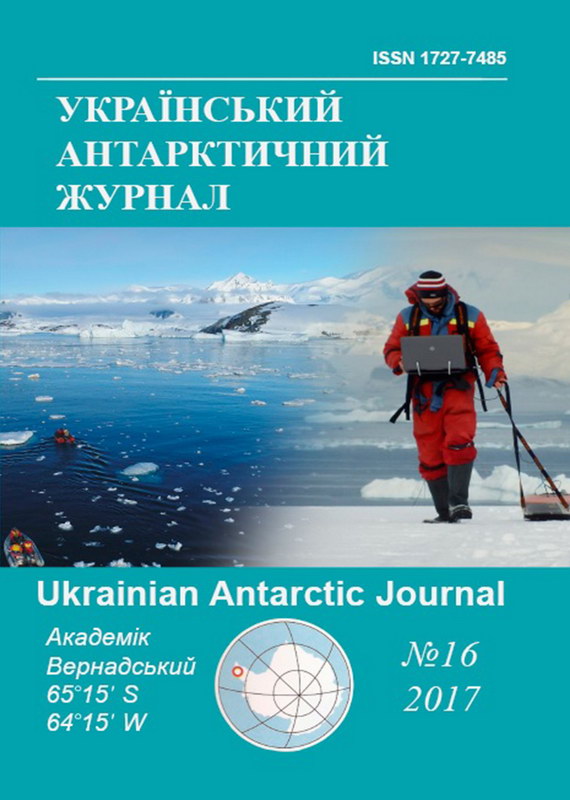Past, present and scenario of the future state of ozone above Aкademiк Vernadsky station in Antarctic season of the ozone hole
- the state of ozone,
- Vernadsky station,
- analogue,
- atmospheric circulation,
- Antarctica
- prediction of the total ozone ...More

This work is licensed under a Creative Commons Attribution-NonCommercial-NoDerivatives 4.0 International License.
Abstract
The main objective of the study is development a method for forecasting the state of ozone above the Ukrainian Antarctic Akademik Vernadsky station since 1972 are presented in the article.The result of study of the state of ozone above Vernadsky station from 1972 is given in the article. An analogue to the state of ozone 2016/2017 is found using the similarity criteria from the observations archive of the station. The proposed model of the change in large-scale atmospheric circulation for the Southern Hemisphere is used to predict the state of the ozone over the Vernadsky station in the next decade. Main conclusion from this study is that in the next decade should expect an increase in the total ozone above the station.
References
- Aleksandrov, E. L., Izrael, Yu.A., Karol, I.L, Khrgian, A.Kh.1992.Ozonnyj shchit Zemli I ego izmenenija [Osone layer of Earth and its changes]. Ozone Shield of the Earth and its Changes. S. -Pb: Hydrometeoizdat.
- Martazinova, V.F., Timofeev, V.E., Ivanova, E.K. 2010. Atmosfernaya tsirkulyatsiya yuzhnoy polyarnoy oblasti i klimat Antarkticheskogo poluostrova [Atmospheric circulation of the southern polar region and the climate of the Antarctic Peninsula]. Kiev: Avers.
- Farman, J.C., B.G.Gardiner, Shanklin, J.D. 1985. Large losses of total ozone in Antarctica reveal seasonal ClOx/NOx interaction. Nature, 315, 297210. https://doi.org/10.1038/315207a0.
- Martazinova V.F. 2005. The classification of synoptic patterns by method of analogs. J. Environ. Sci. Eng, 7, 61-65.
- Martazinova V. 2016. Atmospheric circulation reconstruction over Southern Hemisphere and Antarctica. 7th SCAR Open Science Conference. Kuala Lumpur, Malaysia, 20-30 August, 2016.
- Massom, R. A., Stammerjohn, S. E., Smith, R. C., Pook, M. J., Iannuzzi, R. A., Adams, N., Martinson, D. G., Vernet, M., Fraser, W. R., Quetin, L. B., Ross R.M., Massom Y., Krouse, H. R. 2005. Extreme anomalous atmospheric circulation in the West Antarctic Peninsula region in Austral Spring and Summer 2001/02, and its profound impact on sea ice and biota. Journal of Climate, 19(15), 3544-3571. https://doi.org/10.1175/JCLI3805.1.
- McConnell, J.C., Jin, J.J. 2008. Stratospheric ozone chemistry. Atmosphere-Ocean, 46, 69-92. https://doi.org/10.3137/ao.460104.
- MetOffice 2013.The recent pause in global waming (2): what are the potential causes? URL:https://www.metoffice.gov.uk/binaries/content/assets/mohippo/pdf/q/0/paper2_recent_pause_in_global_warming.pdf.
- Naujokat B., Roscoe, H. K. 2005. Evidence against an antarctic stratospheric vortex split during the periods of pre-IGY temperature measurements. Journal of Atm. Sci., 62, 885-889. https://doi.org/10.1175/JAS-3317.1.
- Randel W. J., Wu, F. 1999. Cooling of the Arctic and Antarctic Polar Stratospheres due to Ozone Depletion. Journal of Climate, 12, 1467-1479. https://doi.org/10.1175/1520-0442(1999)012<1467:COTAAA>2.0.CO;2.
- Solomon, S., Ivy, D.J., Kinnison, D., Mills, M. J., Neely RR 3rd, Schmidt, A. 2016. Emergence of healing in the Antarctic ozone layer. Science. DOI: 10.1126/science.aae0061. https://doi.org/10.1126/science.aae0061.
- Turner, J., King, J. C., Lachlan-Cope, T. A., Jones, P. D. 2002. Recent temperature trends in the Antarctic. Nature, 418, 291-292. https://doi.org/10.1038/418291b.
- Cai, W., Cowan, T. 2007. Trends in southern hemisphere circulation in IPCC AR4 models over 1950-99: ozone depletion versus greenhouse forcing. J. Climate, 20(4), 681-693. https://doi.org/10.1175/JCLI4028.1.
- WMO: Scientific Assessment of Ozone Depletion: 2002. 2003. World Meteorological Organisation, Geneva, Global Ozone Research and Monitoring Project, Report No. 47, 498, URL: https://acd-ext.gsfc.nasa.gov/Documents/O3_ Assessments/Docs/WMO_2002/scientific-assessment2002.pdf.

